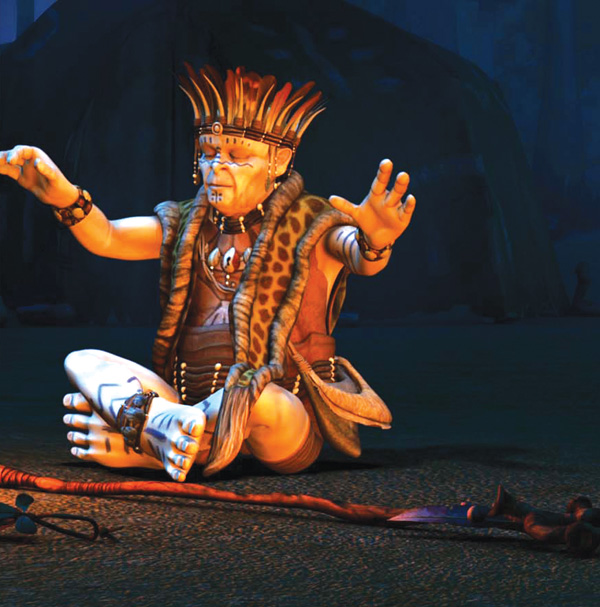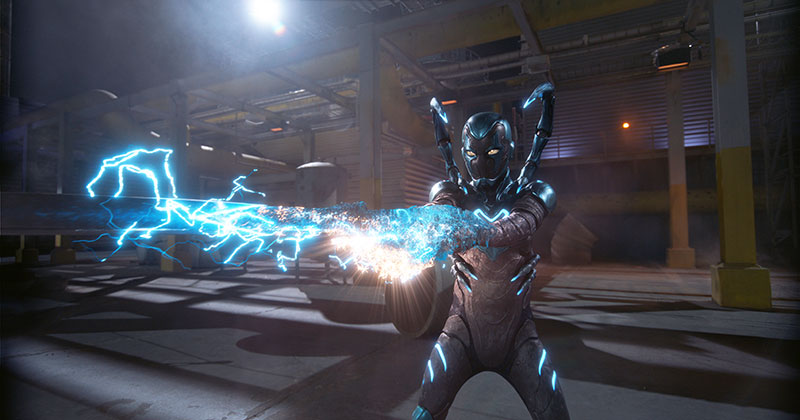|
The wide forest shots were a processing challenge. The team broke up foreground, midground and backgrounds for easier rendering and treated textures and model complexity as separate resolution requirements per shot. Elise explained, "We worked in LOD builds, considering each asset's design and its common use while in preproduction. It also allowed complete control over every asset placement so the director had full flexibility on the look of each shot."
Subtle Style
While at first glance, 'Legend of Enyo' may seem to have a realistic look and feel, early on the decision was made to stylise the assets and backgrounds in a way that was subtle but strong enough to have its own identity. Because a large percentage of the Art Department came from a traditional 2D animated background like Piero - most were former Disney artists - this was a welcome approach. Most of the effects concept design was done by 2D FX artists, producing colour sketches, 2D animations or rough animations in After Effects or Flash, passed to the 3D artists to translate. They generally avoided magical fantasy colours for the effects, keeping them earthy and desaturated.
Among Modelling & Technical Director Elise Deglau's responsiblilities were special effects, many of which involved character interactions. "We were using Maya fluids for special shots where characters wade through water, for example, and often treated the foggy episodes with depth layers in the edit. Explosions and fire would have been tricks with lighting, rendered as a Maya effect and edited in," she said.
2D/3D Blending
Piero said, "Like the lighters, some of the texture artists also found stylising the textures a challenge. But once they understood how to blend a 2D creative idea with a 3D texture, they ran with it. I wanted to see the occasional brush stroke in the textures, whether it was on a rock or on a skin tone. Texture artists frequently carry texture libraries around with them but as the style and look of this production was very specific, we tried to control the texture library as much as possible for consistency.
"Many textures were based on photos that Piero, other artists on the team and I took," said Tim. "Although photos were used as a starting point, the final textures were a blend of photographic and painted elements. The shaders for these textures were generated in Mental Ray utilising multiple layering of maps to achieve the desired look. Normals based bump and displacement maps were used, and a blend of raytraced reflections and reflection maps."
Rocks and More Rocks
Piero said, "I also encouraged the artists to be creative with texture choices, perhaps using an aquatic coral-like texture for wood or a marine skin pattern for plants. After all, this is not planet earth. Most exterior textures had to look weathered by the harsh conditions, but within the dark underworld locations, you will find some of the vibrant colours of the dry world come to life."
Also, despite appearances, their rock texture library wasn't actually that big. Piero preferred form and lighting to determine a change in mood and location, rather than having too many basic texture variants, such as rocks and ground surfacing. However, while many textures could be reused in multiple episodes, several episode-specific textures were made for locations only encountered once or twice. Elise said, "We had default rocks and feature rocks. Each episode needed its own feel as the characters arrived somewhere new. The default rocks would also have to be treated, perhaps just a hue change, to fit into new sets. We swapped out variations and painted the same texture type to fit a new rock shape." The library also contained low and high resolution versions of many textures for close-ups.
Texture Tiles
Producing a high quality 3D series of 26 episodes, travelling through unfamiliar territory, on a modest TV budget required the team to be clever at convincing the audience that every episode played out within a completely new, very large set. Each episode contained several hexagonal sub-sets about 100 metres wide, that could be stitched together on any side, and work as a seamless part of a master set.
"I developed a handful of what I call 'texture tiles' from which, say, a four sided rock pattern can be repeated on all sides endlessly. We only needed a handful of these tiles to cover a long and vast ground surface. We had a few variants on these tiles, such as cracked up dried earth, or mossy ground which would work well for a darker swampy area. The same rule applied to rocks and walls. These tiles could wrap around various shapes with very little touching up.
"The less complicated the texture library is, the less complicated the prop and element library would be. Dressing the large sets came together smoothly, with most dressing elements sitting nicely together."
|
|
Tribal Looks
The characters had to resemble human beings enough for viewers to identify with them, but still look exotic and interesting enough to be recognisable as a different 'race' and hold the audience's attention. "We researched tribes from around the world as reference, but generally found they were all too distinctive and colourful in their dress and decoration. Our brief from the original concept creative was to give the tribe a muted colour palette, blending in with the harsh dry land. We also tried to portray all Doodjie people as equals in design and costume, most wearing very similar armour and dressings. However, a lot of effort was put into the three young lead characters' faces and expressions, giving each a unique look but, at the same time, keeping the differences subtle.
During look development, certain design elements helped the team establish the Doodjie tribe as a nature culture. Physically, they wanted the characters' looks to be almost human, especially in behaviour and personality, but also have some obvious alien features. Piero said, "This tribe has worked hard to stay alive, and this fact should show mentally and physically. They are land travellers living under harsh conditions. They have overstated hands and feet and strong bodies, but are undernourished. They often need to hide and blend into their dangerous surroundings. They also respect the land, only take what they need and travel as light as they can. Like other tribal people, their personal traits are important to their identity."
Villains
This story includes some evil villains, led by Quag Naga, a power hungry tribesman who disappeared for many years into the wilderness and has now returned to wipe out the tribe and make his own way to the Hidden Valley with his henchmen. "Although Quag and his men are the same race as the Doodjies, we made their skin colour paler to show that they had been living and hiding dark, cold places avoiding the sun, to give them a creepier, menacing look."
These marauders also wore more bone and leather dressings, harder than the dressings of the Doodjies, which were softer in look. Other outsiders the Doodjies meet on their journey are not too dissimilar in tone to themselves. As the young shaman, Enyo's own colour is mysteriously different to everyone else's, and an integral part of his lost past and his journey forward.
Rig Economy
Elise explained that various characters could be based on the main characters, with a simple texture change and perhaps a new mask or armour, and use the same rig, but others with size and proportion changes would need a unique rig as well. The animation department started with Anzovin software for Maya on the body rig and then added in custom controls, all built in Maya, where needed for more complexity. Most of the characters could use the same base rig from show to show. Some creatures had separate rigs to animate tentacles and other special body parts in close up shots.
"We had our own facial rig built in Maya. Much thought went into the eye textures and natural skin wrinkles to suit the character type," said Elise. "Some parts of the eyes were made separately to give animators as much control as possible to express emotions. Accounting for the dangling clothing added considerably to the complexity. Quag Naga and Shamani were among the most complex with their overlapping armour and clothing, which always has to be calculated during animation and moved out of the way."
|






















